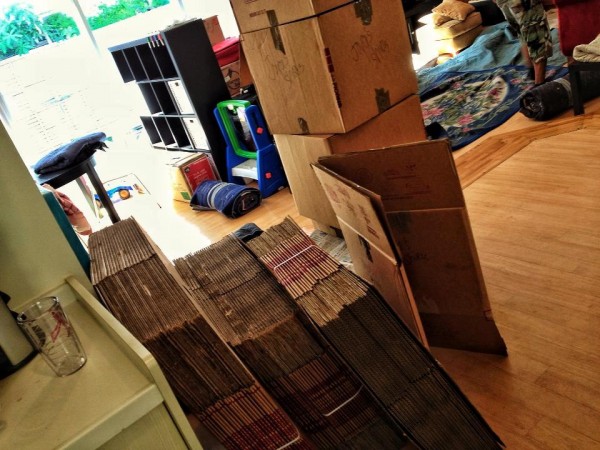CONTRIBUTED BY SHELL BURGER
Editor’s Note: So you’ve already settled into your home in Okinawa, but now you’re itching to move to a better location/house/fill-in-the-blank. If this is you, Shell’s step-by-step guide can help. Next week, she’ll detail her experience with the local moving company her family used.
When we first arrived on island, we had no idea where any of the major towns or activities were located. We only knew Kadena and wherever our various housing agents drove us. So when it came time for us to pick a house, we went after what we thought would be important in the physical house and didn’t really give much thought to the location or distance from the base. However, the more we became accustomed to the island and made friends, the more we realized our original house choice had us feeling distant and isolated.
Toward the beginning of May we decided that it couldn’t hurt to maybe look around and see what was available. Worst case scenario, we stayed where we were. We had almost two months to look around since our lease wasn’t up until the end of June and we were pretty specific on the area we wanted to move into. The downfall with having so much time before our lease expired was most housing agencies did not want to show us houses until we were a couple weeks from moving out. Luckily, Kazumi from Seaside Housing did not believe in this. She started showing us houses right away, and once we found the type and location we wanted, she put us on waitlists until a unit in the area we wanted opened up.
Moving on your own is hard enough, but add into that living overseas where there are specific requirements and expectations, and you have yourself a pretty monumental undertaking. For us, we made a list of everything we knew we would need to do. This included deciding whether or not to actually move, since there would be personal out-of-pocket expenses associated. I will detail below the “steps” on our list and how we handled each item. Hopefully, this will help you if you are thinking about moving.
2. Drive Around Areas you like. For us this part was easy, since we wanted to move into the same area where our friends lived, but I highly recommend you think about where you spend most of your time and start driving around the neighborhoods. See what is out there. This will give you an idea of what you could go after.
3. Contact Housing Agencies to start looking. We started off looking online at the available houses, but as many of you might have figured out the agency websites can be outdated. We also started e-mailing the agencies and explained what we wanted and our situation. This helped weed out the agencies that did not have anything in the area we wanted.
4. Go to Housing Office to get Move-out Paperwork. Once we got word a house would be opening up where we wanted, we obtained the paperwork from the Housing Office to provide to our old housing Agency.
5. Notify your OLD housing agency. For our agency they required a minimum of 30-days notice. We gave them the notice and informed them it could be later than the 30 days depending on when we could sign the new lease and move in. Most agencies will work with you if they know you are moving but a definite date has not been set yet. They mainly want forewarning that you plan to move out.
6. Get Moving Company Quotes. For us we called a couple of different moving companies and had them come out to give free estimates. We had sat down and decided hiring movers would be the best way to go for us. This may not always be the case for everyone, but I do recommend at least get a quote or two so you have the information in case you need it.
7. Put “Hold” deposit down. Once the previous tenants moved out we were able to put a “hold” deposit down to ensure we would get the unit. With Seaside the “hold” deposit is fully refundable.
8. Get lease and property approved by Housing. Once we got the address and a copy of the lease we went to the housing office and had it approved. This was just a preliminary review; this was not an OHA (Overseas Housing Allowance) change. But you will need to have housing review it BEFORE you sign the official lease and pay any fees.
9. Contact your Internet Provider. Since we signed a two-year agreement with NTT through Sunny Net, we went to Sunny Net as soon as we had our address and moving date to transfer service. If you use an intermediary like Sunny Net, the transfer is done by them.
10. Schedule Moving Company. Once we had our moving date, we contacted the movers we selected, Budget Moving, and scheduled them to move us.
12. Move-In Inspection. The night we obtained the keys to our new place we did a thorough walk-through of our house and noted anything that was damaged/broken/missing on the Off Base Move-In Inspection Checklist. We obtained a blank copy of the form from the housing office. It is VERY important to make sure you note anything that is wrong on the form and make sure the housing agency signs it also. This will come in handy when you move out. For example, during our move-out inspection with our old agency they wanted to charge us for items that were missing, but we had noted them missing on our move-in inspection form so we did not have to pay anything. If they had not been noted on the move-in form, we would have been charged.
13. MOVE. The night before the moving company was scheduled; we obtain the keys to our new house. Our movers arrived at 8:30 a.m. and had us moved into our new place by 5:00 p.m. that same day. They also packed us that same day; it was very impressive.
14. Clean OLD Property. If you want to try and avoid paying the “cleaning fee” from the old housing agency you can clean the house, but I will forewarn you they are extremely picky. Since we had a shortened timeline with our move, obtained keys Thursday night, moved Friday, and had inspection Saturday morning, we didn’t want to have to fight with the old agency. We did not clean. We did pick up any trash lying around and straightened/mowed the yard, but that was it.
15. Move-out Inspection. Once your old house is empty (and clean if you are cleaning it yourself) you will schedule a move-out inspection with the old agency. For us the inspector arrived about an hour before we did and had already gone through the whole house. Aside from the cleaning fee which was 42,000 yen, we were charge roughly 10,000 yen for touch-up painting, and 1,500 yen for a broken door lock. We weren’t sure what to expect, but be forewarned they are extremely thorough in inspecting. Your lease/rent will end with the old agency on the move-out inspection date so be sure not to let this date get away from you. You will be paying rent out of your own pocket for any overlap days.
16. Obtain Final Bill and Refund from Old Agency. It will normally take the old agency about a week to get all the final bills from utility companies. For us this was a little faster. We had our move-out inspection on a Saturday and had our final paperwork and refund on that Wednesday. They will refund whatever pro-rated rent and deposits you are due in Yen. For us, we went ahead and paid the full month of June rent and received a refund of the un-used amount.
17. Schedule your OHA/LQA change with Housing. Once you have your final paperwork from the old agency you will need to schedule an appointment with the housing office to get your OHA change paperwork.
18. Schedule your OHA/LQA change with Finance. After meeting with the housing office you would then schedule an appointment with your finance office to submit your new paperwork for the change. This would also be when you can request the agency fee reimbursement if you qualify. If you are a civilian with LQA, as long as you are under your annual cap the agency fee should be reimbursable, but double check with your finance person to be sure.
Moving can be a very complicated but hopefully my checklist will help those of you thinking about moving decide if it is the best thing for you and your family.

